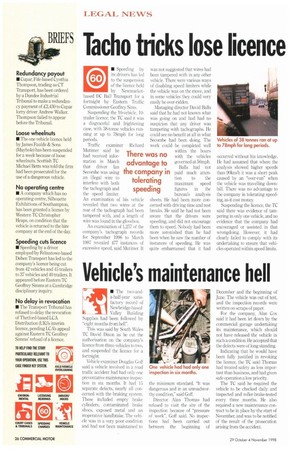B'S Tacho tricks lose licence
Page 28

If you've noticed an error in this article please click here to report it so we can fix it.
• Speeding by its drivers has led to the suspension of the licence held by Newmarketbased DC Ball Transport for a fortnight by Eastern Traffic Commissioner Geoffrey Sims.
Suspending the 7.0-vehicle, 10trailer licence, the TC said it was a disgraceful and frightening case, with 38-tonne vehicles running at up to 78mph for long periods.
Traffic examiner Richard Mutimer said he had received information in March that driver Ian Secombe was using an illegal wire to interfere with both the tachograph and the speed limiter. An examination of his vehicle revealed that two wires at the rear of the tachograph had been tampered with, and a length of wire was found in the glovel.m.
An examination of 1,257 of the company's tachograph records for September 1996 to March 1997 revealed 477 instances of excessive speed, said Mutimer. It
was not suggested that wires had been tampered with in any other vehicle. There were various ways of disabling speed limiters while the vehicle was on the move, and in some vehicles they could very easily be over-ridden.
Managing director David Balls said that he had not known what was going on and had had no suspicion that any driver was tampering with tachographs. He could see no benefit at all in what Secombe had been doing. The work mild be completed well within the hours with the vehicles governed at 56mph.
Balls had not paid much atten tion to the maximum speed figures in the bureau's analysis sheets. He had been more concerned with driving time and rest breaks. He said he had not been aware that the drivers were speeding, and did not encourage them to speed. Nobody had been more astonished than he had been when he saw the number of instances of speeding. Ile was quite embarrassed that it had occurred without his knowledge. He had assumed that where the analysis showed higher speeds than 90km/h it was a short peak caused by an "over-run" when the vehicle was travelling downhill. There was no advantage to the company in tolerating speeding, as it cost money.
Suspending the licence, the TC said there was evidence of tampering in only one vehicle, and no evidence that the company had encouraged or assisted in that wrongdoing. However, it had clearly failed to comply with its undertaking to ensure that vehicles operated within speed limits.
















































































































